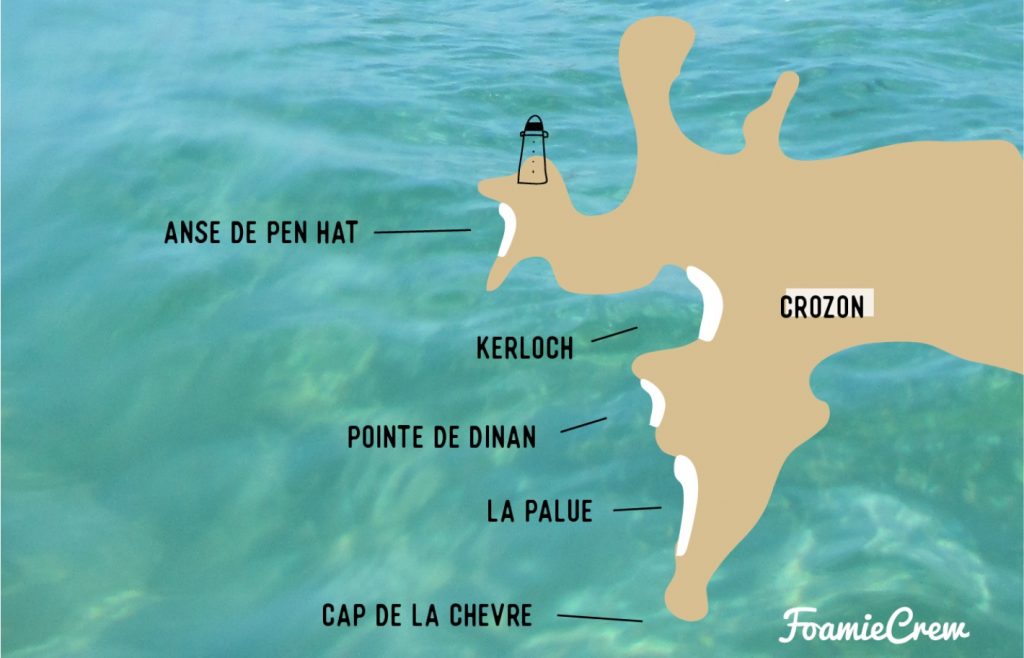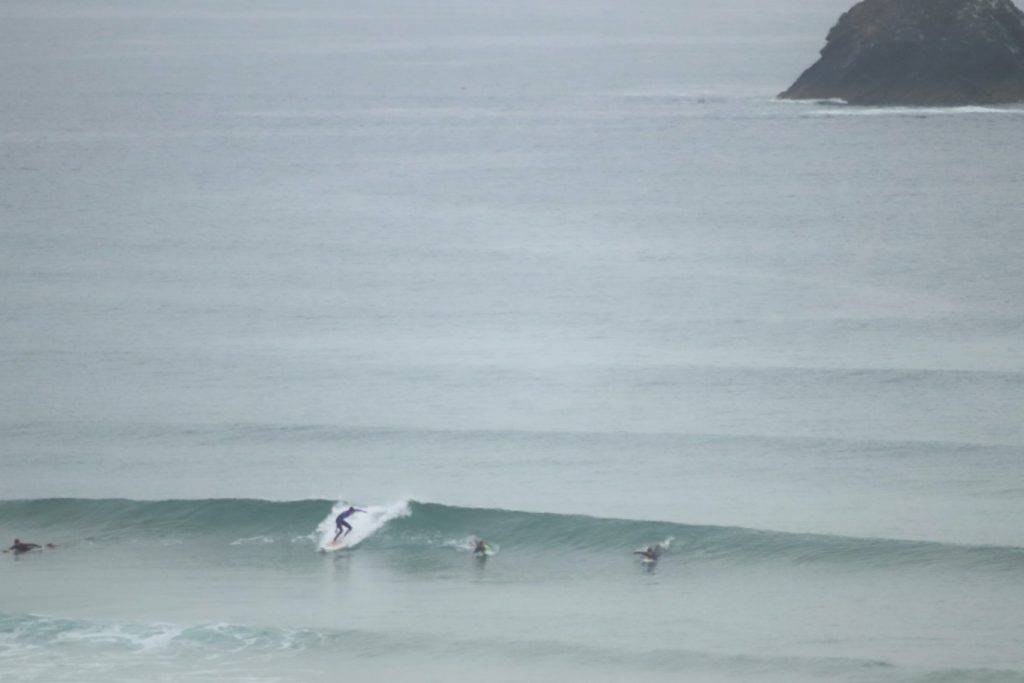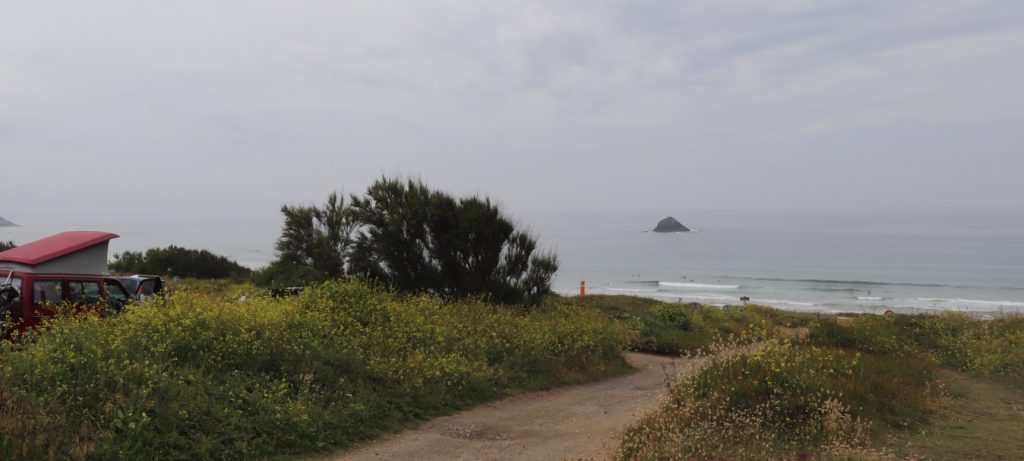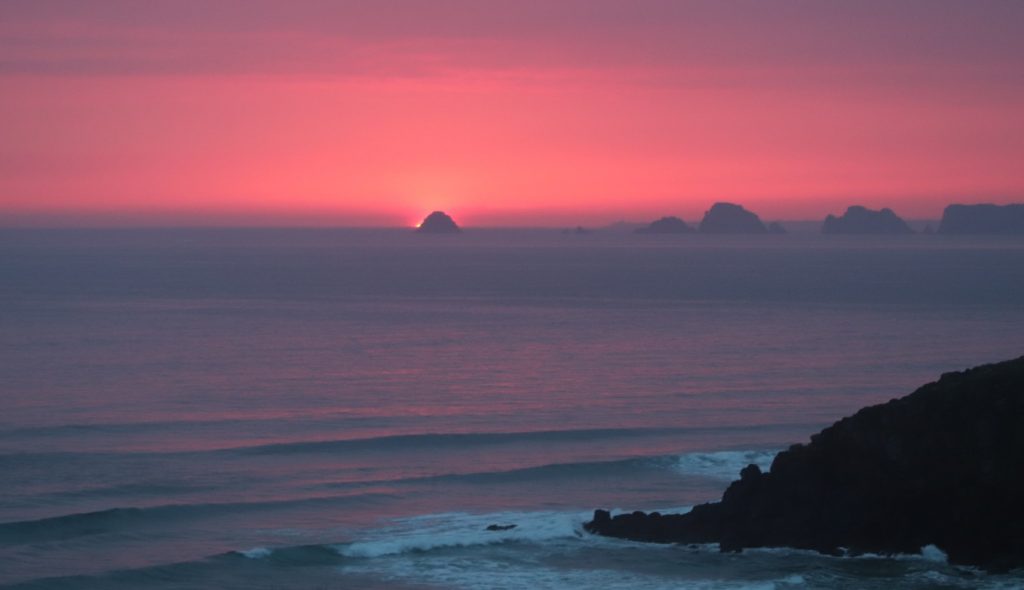Brittany, or Bretagne, in France, is one of our favorite surfing destinations. Brittany is home to many surf spots, such as La Torche, La Palue and Quiberon. The Crozon Peninsula is a perfect surf destination when there is not much swell in the Atlantic. When the waves are under 4 ft, La Palue is one of the only beaches that produces waves. Crozon is still a bit undiscovered by surfing tourism (for example, there are no surf hostels and no surf webcams at Crozon).
Here’s FoamieCrews little guide on surfing La Palue beach at the Crozon Peninsula.

The main surf spots in Crozon
Surfing in Brittany, France
Sheltered bays, beautiful blue water and a perfect escape from the summer city heat. Not as crowded as the south of France ánd better protected from thermal winds! Brittany has is brilliant for surfers from all abilities.
Basically, Brittany can be divide into three coastlines. The northern part, facing the Channel, where Saint Malo and Perros Guirec are located. Brittany North is one of the few surf destinations where you’ll find protection against winds from the west. You can read our guide on surfing Locquirec (Pors ar Villec) here.
Then, there’s the South coast of Brittany. Here you’ll find spots that come to life with bigger swells, such as the Quiberon Peninsula.
Finally, there’s the fingers of land stretching far into the Atlantic: the outer West coast of Brittany. The province is called Finistère, ‘the end of the world’. Surf tourism is still on the rise here. No partying surf camp youth, no overcrowded parking lots, no surf hostels. It’s still possible to find empty waves, especially in the off-season.
What might one consider as drawbacks when it comes to surfing in Brittany? The water is a bit colder than in the South of France. Right now, almost July, it’s still 15 degrees. Secondly, the tides have a big influence. Some surf spots only work on high tide, others only on low tide. Thirdly, the ocean can be a bit tricky here. Underwater rocks and reefs are common and most beaches do not have lifeguard surveillance.
When there’s little swell on the map you’d better go as far West as you can. That’s why we ended up at the Crozon Peninsula, one of the most exposed stretches of land in France.
About the Crozon Peninsula
The peninsula of Crozon is close to Brest, at the western point of Brittany. The French call it the ‘Presqui’ile de Crozon’, which I find hilarious. It means the ‘almost island’ of Crozon. It’s a beautiful picturesque place with some small villages, some cozy campsites and multiple beaches. When there are no waves you can rent a sailboat at Morgat, eat seafood at the little harbour town of Camaret sur Mer or hike the gorgeous trails along the coastline. Crozon is pretty mountainous and has beautiful cliffs. This gives us a variety of reefs and sheltered bays which makes this a perfect surfing destination.
Crozon surf spots
From North to South
- Anse de Pen-Hat
- Kerloch
- Pointe de Dinan
- La Palue
- Cap de la Chèvre
We only surfed La Palue (4 days straight!). It was the only surf spot in Brittany that was getting any waves that week. In the future we hope to publish more about the other surf spots on Crozon.
Surf la Palue
La Palue is the most well-know surf spot in Crozon, if not of Brittany. It catches the most swell. La Palue is a long, west facing stretch of beach. It’s a cobble/sand bottom floor that gradually descends into the Atlantic. Why is that important? Because it’s one of the few Breton beaches that is surfable at all tides. High tide is certainly best: it pushes the waves onto the inner banks and produces nice A-frame waves.
At 2-4 ft on 10 seconds it was perfect: hip to shoulder high waves breaking all day. A bit smaller on low tide, a bit stronger on high. With these easy conditions we didn’t experience a lot of rips and currents.

There are some rocks but La Palue is mostly a sandy bottom wave. There are multiple peaks which, depending on the sand banks, can produce long peeling lefts and rights. When it’s small, it’s a perfect soft top or longboard wave. However, it’s not a slow or fat wave. The waves don’t really barrel but produce good, steep shoulders. La Palue, even at 3 or 4 ft, is still steep enough to shortboard.
You can access La Palue via a pretty steep dirtroad. Close to the beach there is some space for parking. When we visited, there was a car height limit of 2 meter. Taller vans can park on top of the hill.

I could not find a webcam for La Palue or a surf webcam for Crozon. This is part of the charm, of course, but also makes it a bit difficult to decide what spot to drive to. Main rule is: with small, clean swell, La Palue is the most consistent break. Some Breton surfers call it a swell magnet.
When we were there, with a 3 foot swell, the waves were perfect. When at Crozon I checked the surf webcams of Trépassés and La Torche and I was glad that we were at La Palue! It seemed to attract more waves than the other beaches in Brittany.

Camping close to the surf at Crozon
Info for vanlifers: There’s a camper spot in Morgat with a toilet and walking distance to the harbor and it’s cafés. From there, it’s only a 10 minute drive to La Palue. At the La Palue hills it’s forbidden to camp but when we were there in June, a few little buses and vans spent the night at La Palue.
At the south end of the Kerloch bay you will find the lovely camping Plage du Goulien. It’s tucked away in the forest and even has a special wetsuit-cleaning shower. Wildcamping on Crozon is not allowed but it happens plenty in the off-season.
If you want to see more of surfing in Crozon, check out the video we made of surfing the MF Little Marley. This review movie is filmed entirely on Crozon. See video here.




